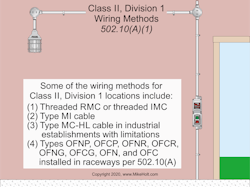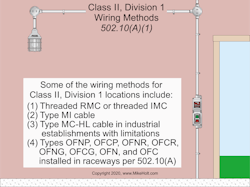Courtesy of www.MikeHolt.com
All questions and answers are based on the 2020 NEC.
Q. What wiring methods are acceptable to the NEC in Class II, Division 1 locations?
See answer below.
A. The following wiring methods can be installed in a Class II, Division 1 location [Sec. 502.10 (A)]: (Figure)
(1) General.
(1) Threaded rigid metal conduit (Type RMC) or threaded intermediate metal conduit (Type IMC).
(2) Type MI cable terminated with fittings that are listed for the location.
(3) In industrial establishments with restricted public access where only qualified persons will service the installation, MC‑HL cable listed for use in Class II, Division 1 locations with a gas/vaportight continuous corrugated metallic sheath, an overall jacket of suitable polymeric material, a separate equipment grounding conductor(s) sized in accordance with Sec. 250.122, based on the rating of the overcurrent protective device, and terminated with fittings that are listed for the location.
(4) Types OFNP, OFCP, OFNR, OFCR, OFNG, OFCG, OFN, and OFC optical fiber cable can be installed in raceways [Sec. 502.10(A)] and must be sealed in accordance with Sec. 502.15.
(2) Flexible Connections. If flexibility is necessary, any of the following wiring methods are permitted in a Class II, Division 1 location:
(1) Dusttight flexible connectors.
(2) Liquidtight flexible metal conduit, (Type LFMC), with listed fittings.
(3) Liquidtight flexible nonmetallic conduit, (Type LFNC), with fittings that are listed.
(4) Interlocked armor Type MC cable with an impervious jacket and termination fittings that are listed for Class II, Division 1 locations.
(5) Flexible cords listed for extra‑hard usage, containing an equipment grounding conductor and terminated with listed dusttight flexible cord connectors. The flexible cord must be installed in accordance with 502.140.
(3) Boxes and Fittings. Boxes and fittings must be provided with threaded bosses and must be dusttight. Boxes and fittings in which taps, joints, or terminal connections are made, or used in locations where dusts are of a combustible, electrically conductive nature [Sec. 500.6(B)(1) Group E], must be identified for Class II locations.
These materials are provided to us by Mike Holt Enterprises in Leesburg, Fla. To view Code training materials offered by this company, visit www.mikeholt.com/code.
About the Author

Mike Holt
Mike Holt is the owner of Mike Holt Enterprises (www.MikeHolt.com), one of the largest electrical publishers in the United States. He earned a master's degree in the Business Administration Program (MBA) from the University of Miami. He earned his reputation as a National Electrical Code (NEC) expert by working his way up through the electrical trade. Formally a construction editor for two different trade publications, Mike started his career as an apprentice electrician and eventually became a master electrician, an electrical inspector, a contractor, and an educator. Mike has taught more than 1,000 classes on 30 different electrical-related subjects — ranging from alarm installations to exam preparation and voltage drop calculations. He continues to produce seminars, videos, books, and online training for the trade as well as contribute monthly Code content to EC&M magazine.


